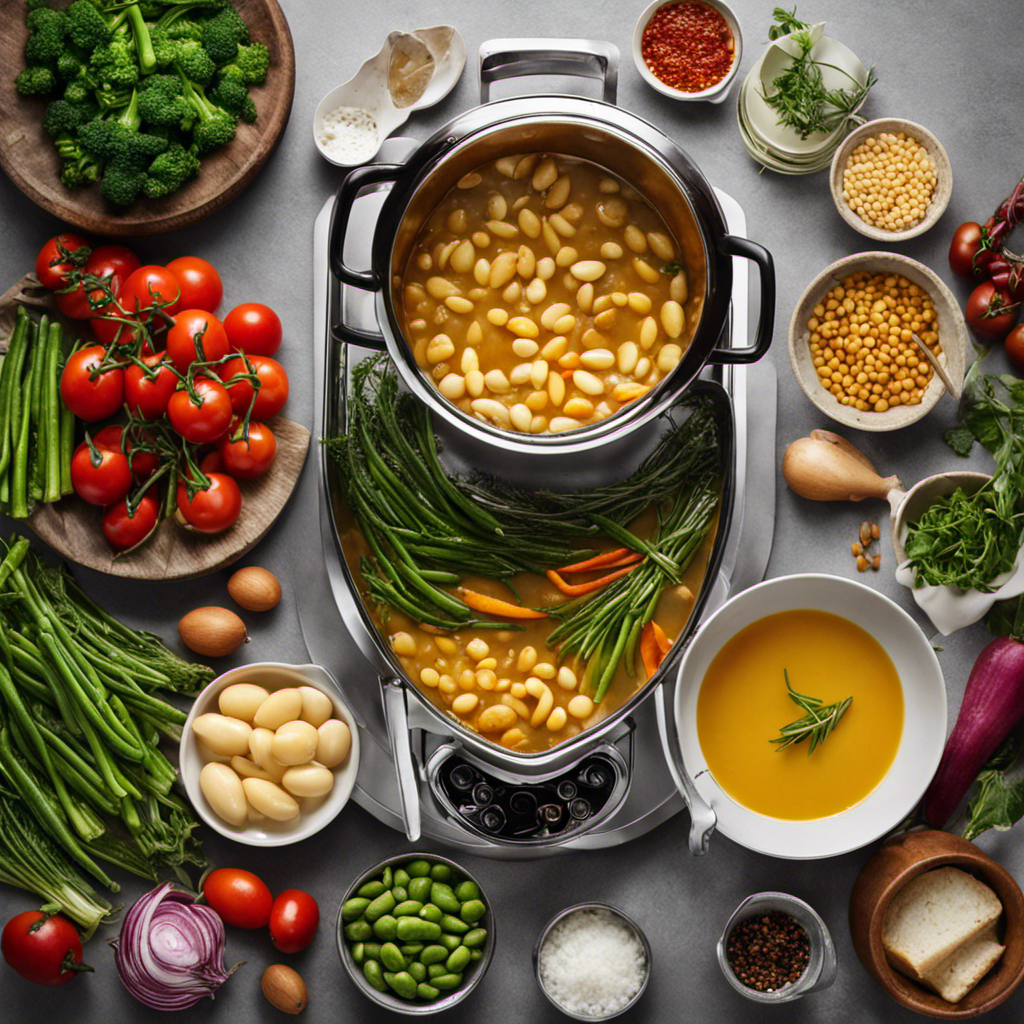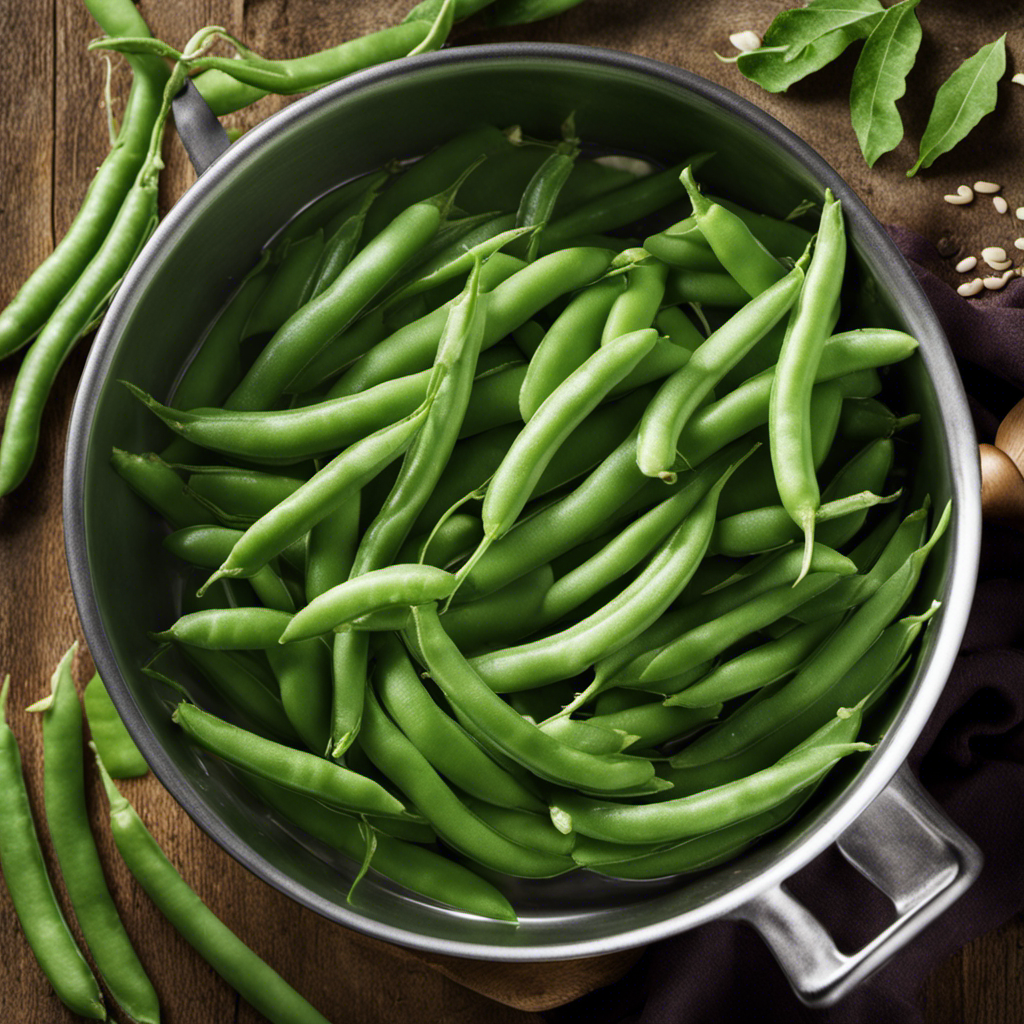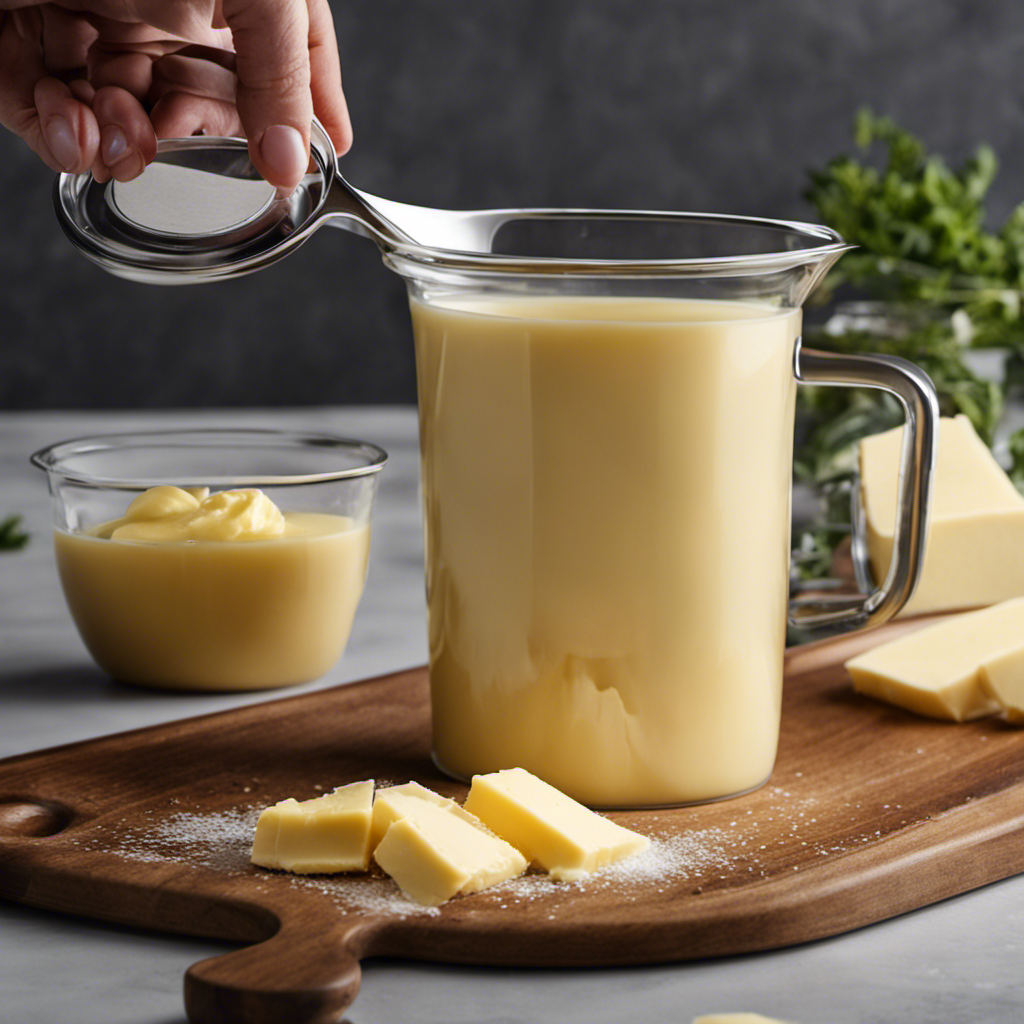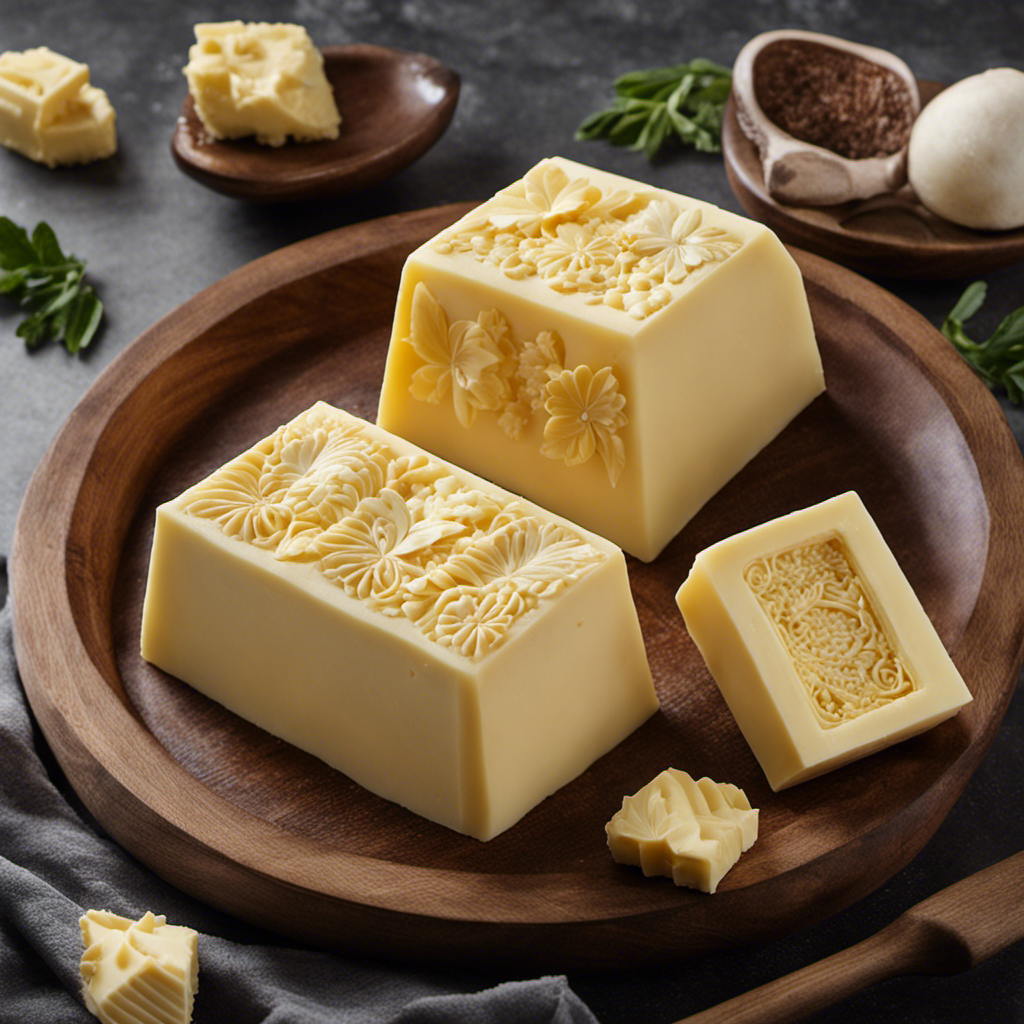I have always appreciated the convenience of canned beans, and butter beans are no different.
In this article, I’ll walk you through the steps of cooking canned butter beans to perfection. From choosing the right beans to adding the perfect blend of seasonings, I’ll guide you every step of the way.
So grab a can of butter beans and let’s get started on this delicious culinary journey together.
Key Takeaways
- Read labels for preservatives and sodium content
- Choose cans with no added preservatives and low sodium content
- Store beans in a cool, dry place away from sunlight and strong-smelling foods
- Explore different cooking methods and seasonings to enhance flavor
Choosing the Right Canned Butter Beans
When choosing the right canned butter beans, it’s important to read the labels for any added preservatives or sodium content. This will help you choose the best brand that fits your dietary needs.
Look for cans with no added preservatives and low sodium content to ensure you’re getting a healthier option. Additionally, consider the brand’s reputation for quality and taste. Some brands may have a better texture and flavor, so it’s worth trying different ones to find your favorite.
Once you’ve chosen your canned butter beans, it’s important to store them properly. Keep them in a cool, dry place, away from direct sunlight. Avoid storing them near strong-smelling foods as they can absorb odors.
With your canned butter beans selected and stored correctly, you’re ready to move on to preparing the ingredients for a delicious meal.
Preparing the Ingredients
First, make sure you have all the necessary ingredients ready for preparing the butter beans. For this recipe, you will need the following:
-
Canned butter beans: Choosing the right beans is crucial for a successful dish. Look for beans that are plump, firm, and free from any signs of damage or spoilage.
-
Water: You will need enough water to cover the beans completely while cooking.
-
Salt: Adding salt enhances the flavor of the beans. Use it sparingly, as you can always add more later if needed.
-
Optional seasonings: Depending on your preference, you can add additional seasonings such as garlic, onion, herbs, or spices to enhance the taste of the beans.
Now that you have gathered all the necessary ingredients, you can move on to the next step: choosing the cooking method that best suits your preference.
There are various cooking methods you can use, including stovetop simmering, pressure cooking, or slow cooking in a crockpot. Each method will yield slightly different results in terms of texture and flavor.
Choose the method that aligns with your desired outcome and follow the instructions accordingly.
Draining and Rinsing the Canned Butter Beans
Make sure to drain and rinse the canned butter beans before using them in the recipe. Draining and rinsing the beans is an important step to remove excess salt and any residue from the can.
To drain the beans, simply open the can and pour the contents into a colander or strainer. Allow the liquid to drain completely, gently shaking the colander if needed.
Once the beans are drained, rinse them under cold running water. This will further remove any excess salt and help freshen up the beans.
Now, you’re ready to use the beans in your recipe. Aside from cooking, canned butter beans can also be used in salads, soups, stews, and even mashed as a spread or dip. Get creative and explore the various alternative uses of canned butter beans.
Sautéing the Aromatics
After draining and rinsing the canned butter beans, it’s time to sauté the aromatics. This step is crucial as it adds depth and flavor to your butter bean recipes. Here’s how to do it:
- Heat some olive oil in a pan over medium heat.
- Add finely chopped onions and garlic to the pan and sauté until they become translucent and fragrant.
- For an extra kick, you can also add diced bell peppers or chili flakes to the mix.
- Once the aromatics are cooked, add the drained and rinsed butter beans to the pan and stir them together with the onions and garlic.
Sautéing the aromatics before adding the beans infuses them with a delicious flavor and ensures that every bite is bursting with taste. This alternative cooking method elevates the dish and makes it a standout among butter bean recipes.
Adding the Canned Butter Beans to the Pan
Once the sautéed aromatics are ready, it’s time to mix them with the drained and rinsed butter beans in the pan. This step is essential for infusing the beans with delicious flavors.
Cooking techniques vary, but I prefer to gently toss the beans in the pan, ensuring each bean is coated with the aromatic mixture. The heat from the pan helps to warm up the beans, making them even more enjoyable to eat.
As the beans cook, they absorb the flavors of the aromatics, creating a mouthwatering combination. This technique can be used in a variety of alternative recipes, such as salads, stews, or even dips.
Now that the beans are combined with the aromatics, it’s time to move on to the next step – seasoning and flavoring the beans.
Seasoning and Flavoring the Beans
Now, it’s time for you to add a pinch of salt and a sprinkle of your favorite herbs and spices to enhance the flavor of the beans. Flavoring canned butter beans is all about using the right combination of herbs and spices to bring out their natural taste.
Here are some flavoring techniques that you can try:
-
Garlic and onion powder: These two spices add a savory and aromatic flavor to the beans. Just a teaspoon of each will do the trick.
-
Paprika: This spice adds a subtle smoky flavor and a hint of sweetness to the beans. Sprinkle a teaspoon for a touch of warmth.
-
Italian seasoning: A blend of herbs like basil, oregano, and thyme can elevate the flavor of the beans. Use about a tablespoon for a Mediterranean twist.
-
Hot sauce: If you like a bit of heat, a few dashes of hot sauce can give the beans a spicy kick. Adjust the amount according to your preference.
Simmering the Beans to Perfection
When it comes to simmering beans to perfection, there are a few key points to keep in mind.
First, the optimal simmering time can vary depending on the type of bean and desired texture.
Second, incorporating flavor-enhancing ingredients like herbs, spices, and aromatics can take your beans to the next level.
Lastly, achieving a consistent texture in cooked beans is crucial, whether you prefer them to be soft and creamy or slightly firm and toothsome.
Optimal Simmering Time
For best results, simmer the canned butter beans for about 20 minutes until they are tender and flavorful. Simmering time can vary depending on personal preference and desired bean texture.
Here are some tips to determine if your canned butter beans are cooked properly and how to adjust simmering time for different textures:
-
Check the tenderness: The beans should be soft and easily mashed with a fork, but not mushy.
-
Taste test: Take a spoonful of beans and taste for tenderness and flavor. They should be fully cooked and have a creamy texture.
-
Adjust simmering time: If the beans are too firm, continue simmering for a few more minutes until desired tenderness is achieved. If they are overcooked, reduce simmering time for future batches.
-
Experiment: If you prefer beans with a firmer texture, reduce simmering time. For a softer texture, increase simmering time, but be careful not to overcook.
Flavor-Enhancing Ingredients
Adding ingredients like garlic, onions, and herbs can enhance the flavor of your simmered butter beans. These flavor-boosting additions can take your dish from ordinary to extraordinary.
Garlic adds a pungent and aromatic taste, while onions provide a sweet and savory note. Fresh herbs like rosemary, thyme, or parsley can infuse the beans with a burst of freshness.
When cooking butter beans, it’s important to use the right cooking techniques to maximize flavor. Sautéing the garlic and onions before adding the beans can bring out their natural sweetness and depth of flavor. Additionally, simmering the beans in a flavorful broth or stock can further enhance their taste.
By incorporating these flavor-enhancing ingredients and cooking techniques, you can elevate the flavors of your simmered butter beans to new heights.
As we discuss the importance of enhancing flavors in simmered butter beans, it is also crucial to pay attention to the consistency of the cooked beans.
Consistency of Cooked Beans
The texture of the cooked beans is influenced by the length of time they are simmered. The longer the cooking time, the softer the beans become. This can be adjusted based on personal preference, whether you prefer a firmer or creamier texture.
Here are four key factors to consider when determining the cooking time for your beans:
-
Soaking time: Pre-soaking the beans overnight can help reduce the overall cooking time and result in a more tender texture.
-
Simmering time: Once the beans are soaked, they should be brought to a boil and then simmered for the recommended time, usually around 1-2 hours, until they reach the desired tenderness.
-
Test for doneness: To check if the beans are cooked to your liking, take a few beans and gently press them between your fingers. They should be soft and easily mashable.
-
Resting time: After the beans are cooked, allow them to rest in their cooking liquid for about 10-15 minutes. This helps them absorb any remaining moisture and further enhances their texture.
Serving and Enjoying Your Cooked Canned Butter Beans
To fully enjoy your cooked canned butter beans, try seasoning them with a sprinkle of salt and pepper. This simple addition enhances the flavors of the beans and brings out their natural taste. Canned butter beans are versatile and can be served in various ways. They can be added to salads, soups, stews, or even mashed to make a creamy side dish. These beans are not only delicious but also packed with nutritional benefits. They are a good source of fiber, protein, and essential vitamins and minerals. Incorporating butter beans into your diet can promote digestive health, support muscle growth, and boost your immune system. So why not try different serving suggestions and reap the nutritional benefits of these tasty beans?
| Serving Suggestions | Nutritional Benefits |
|---|---|
| Add to salads | High in fiber |
| Mix in soups | Good source of protein |
| Mash as a side dish | Packed with vitamins and minerals |
| Use in stews | Boosts immune system |
Frequently Asked Questions
How Long Do Canned Butter Beans Last in the Pantry Before They Expire?
Canned butter beans typically have a shelf life of 2-5 years when stored properly in a pantry. To ensure they last longer, store them in a cool, dry place away from direct sunlight or heat sources.
Can I Use Dried Butter Beans Instead of Canned Butter Beans for This Recipe?
I prefer using dried butter beans instead of canned ones for this recipe. They have a richer flavor and texture. Soaking them overnight helps to reduce cooking time and improves digestibility.
Can I Freeze Cooked Canned Butter Beans for Later Use?
Yes, you can freeze cooked canned butter beans for later use. They are a versatile ingredient and can be used in various dishes like soups, stews, salads, or even mashed into a dip. Freezing preserves their flavor and texture.
How Can I Make the Canned Butter Beans Taste Less Salty?
To make canned butter beans less salty, I rinse them under cold water before cooking. Adding a pinch of sugar or a squeeze of lemon juice can also help balance the flavors and enhance the taste.
Can I Substitute Canned Butter Beans With Another Type of Bean in This Recipe?
Yes, you can substitute canned butter beans with other types of beans in this recipe. Some alternatives include kidney beans, navy beans, or cannellini beans. Just make sure to adjust cooking times accordingly.
Conclusion
In conclusion, cooking canned butter beans is like transforming plain pebbles into shiny gems.
With the right ingredients and techniques, you can create a symphony of flavors that dance on your taste buds.
The sautéed aromatics infuse the beans with a tantalizing aroma, while the simmering process allows the flavors to meld together like a tightly knit family.
So, grab a fork and dive into a bowl of these perfectly cooked canned butter beans, and let their velvety texture and savory taste transport you to culinary bliss.









